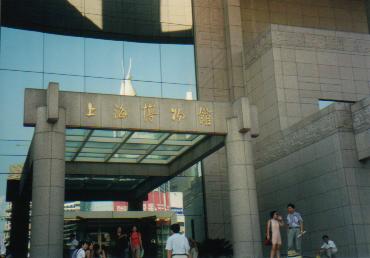| Museum > Art |
|
|
Shanghai Museum
The museum contains more than 112,000 Chinese cultural relics from the Old Stone Age to modern times, including bronzeware, calligraphy, paintings, pottery, porcelain, jadeware, stone carvings, Jiaguwen (inscriptions on tortoise shells or animal bones), imperial seals, ancient coins, silk embroidery, dyed fabrics, ivory sculptures, ethnic crafts, as well as relics unearthed in Shanghai where bronzeware, pottery, porcelain and calligraphy are among the best in China. Regarding sacrificial bronze vessels and musical instruments, some important collected articles from the Western Zhou Dynasty (1100BC-771BC) include Defang Ding (the reign of King Cheng), Dayu Ding (the reign of King Kang), Dake Ding and Xiaoke Ding (the reign of King Xiao), Shihu Gui and Shidui Gui (the reign of King Yi), as well as Song Ding (the reign of King Kang), Xi Zun, Niaoshoulongwen Pot, Qihou Pot, Zhugonghua Zhong, Tianqisanliang and Shangyangsansheng. Unearthed in Liyu Town of Hunyuan, they are important bronzeware relics from the Spring and Autumn Period (770-476BC). Among porcelain works, some remarkable pieces include celadon Zun of the Shang Dyndasty (1600-1100BC), Yingzi Box of Xing Kiln, Haitangshi Bowl of Yue Kiln in the Tang Dynasty (618-907), a series of dishes of Ru Kiln in the Song Dynasty (960-1279), Guan'er Bottle of Guan Kiln in the Southern Song Dynasty (1127-1279), Qinghualianhua Pot of Jingdezhen Kiln in the Yuan Dynasty (1279-1368), flamb¨¦ glazed plate of Jingdezhen Kiln, Qinghua Kongque Lanyou Plate of Jingdezhen Kiln in the Ming Dynasty (1368-1644), and many more.
Among over 10,000 pieces of paintings and calligraphic works -- Yatouwantiejuan by Wang Xianzhi of the Jin Dynasty (265-420), Kuxuntiejuan by Huaisu, Qianziwenjuan by Gaoxian, Gaoyitujuan by Sunwei of the Tang Dynasty (618-907), Xiashantujuan by Dong Yuan of the Five Dynasties (907-960) -- belong to the early period. Outstanding works from the Song Dynasty (960-1279) collected at the museum include Liuyaluyantu and Qianziwenjuan by Zhao Ji, Yu Xie Mingshi Lunwenjuan by Su Shi, Huayanshujuan by Huang Tingjian, Duojingloushice by Mi Fu, Yougutuzhou by Guo Xi, Xuejiguanmeitu by Ma Yuan and Huaniaozhou by Li Di, to name a few. Famous works of the Yuan Dynasty are Qingbianyingjutuzhou by Wang Meng, Yufutujuan by Wu Zhen, Dongtingdongshantuzhou by Zhao Mengfu, Yuzhuangqiujituzhou and Liujunzituzhou by Ni Zan. As to works of the Ming and Qing dynasties (1368-1911), dozens of consummate and representative works are on display at the Shanghai Museum which has been the collecting center of painting and calligraphy in the Jiangna area. The seal collection of the Ming and Qing dynasties are the best in China. A large jade sacrificial vessel from the Liangzhu Culture is the most distinctive among the archaeological discoveries.
Covering a construction area of 28,000 square meters, the museum contains four exhibition halls containing Chinese bronzeware, pottery and porcelain, painting and ancient sculpture. Many exhibitions from the Shanghai Museum have traveled to Hong Kong, Japan and America, such as the Bronzeware Exhibition of the Shanghai Museum, Exhibition of Chinese Art in Six Thousand Years, Porcelain Exhibition of the Shanghai Museum, Exhibition of Calligraphy of the Ming and Qing Dynasty, Exhibition of Works by the Eight Eccentrics of Yangzhou, Exhibition of Studies of Scholars in the late Ming Dynasty, and so on.
Scientific research at the museum has also produced abundant achievements. Significant research includes dating the pottery by thermoluminescence, the application of bromine methane in protecting cultural relics, the application of soft x-rays in protecting cultural relics and archaeological research, and so on. The Shanghai Museum is the first in China to feature relic dating techniques using thermoluminescence, laser holography and vacuum free-drying.
The museum also compiled such picture books as the Painting Collection at Shanghai Museum, Bronzeware Collection at Shanghai Museum, Pottery and Porcelain Collection at Shanghai Museum, Shanghai Museum, Seal Collection at Shanghai Museum, Calligraphy Collection of the Ming and Qing Dynasties at Shanghai Museum, Shuochang Script of Ming Chenghua, and dozens of other picture books of special subjects. The museum's annual magazine is called Collected Papers of Shanghai Museum. |
||||
 |
